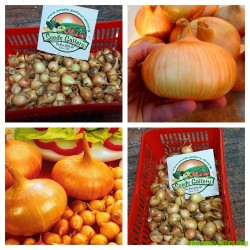- -15%

Odrůda z Německa









Stuttgarter Reisen je chutná stará oblíbená skladovací cibule a je snadné pochopit proč. Vyrábí středně velké žluté cibule ve zralosti a mají jemnou, hladkou až mírně štiplavou chuť, díky které jsou ideální pro čerstvé použití, grilování a vaření.
Stuttgarter Reisen je chutná stará oblíbená skladovací cibule a je snadné pochopit proč. Vyrábí středně velké žluté cibule ve zralosti a mají jemnou, hladkou až mírně štiplavou chuť, díky které jsou ideální pro čerstvé použití, grilování a vaření.
Fantastické jsou také nakrájené syrové v salátech nebo na sendvičích. Žárovky jsou jednotné velikosti s mírně zploštělým tvarem.
Jsou to vynikající skladovací cibule a lze je skladovat několik měsíců po sklizni. Pro jemnou zelenou cibuli sklízejte cibuli asi 2-4 týdny po výsadbě.
Italian onions are long-day onions. That means that they do best at higher latitudes (above 37 degrees or so — north of a line from southern Virginia to San Francisco). While you can direct seed in the early spring, you will get the largest bulbs if you grow your own onion seedlings. However, some varieties have done very well from direct seeding in our trial gardens. Follow these simple techniques for perfect Italian onions.
For Transplants: Start your seedlings 10-12 weeks before the time you plan to set them out. You can set them out in the early spring about two or three weeks before the last frost date.
To start your seedlings, put a growing mix (either store-bought or homemade from 1/2 finely sifted peat, 1/2 finely sifted compost, and 1/2 handful of lime per bushel of mix) about 4 inches deep in a flat. Wet mixture thoroughly. Put your onion seed on top trying to space the seeds about 1/4 to 1/2 inch apart. Cover with 1/4 inch soil mix or preferably vermiculite. Water again & set seeds in a warm place. As soon as they germinate, get them under grow lights. You can begin to feed them a week or so after they have germinated.
You want them to have plenty of space, so pull and discard any seedlings that are more than about 1/2 inch from the next one. Allow keeping growing. If they begin to get too tall, you can give them a 'haircut' with scissors. Just snip off the top inch or two of the seedlings. They will do fine.
About a week to ten days before you plan to set them out, begin to harden them off by putting them outside in a sheltered place for a few hours. Increase the time every day.
To plant out, have a well-dug bed with good fertility. Onions benefit from the soil with high phosphorus content. Plant them about three inches apart in rows set about 10 inches apart. Keep well watered throughout the growing season. Onions benefit from good fertile soil, so give your crop several side dressings.
GROWING YOUR OWN ONION SETS. This is really easy and makes life easier next spring. Sow your seed for onion sets about three-four months before your expected hard frost. Prepare a nice bed. Add some good compost or 10-10-10 if you do not have any. Rake well. Scatter your onion seeds and try and get them about 1/4 inch apart. Firm them down by hand and cover with 1/4 inch soil. Keep well watered until they germinate and provide supplemental irrigation. Just let them grow. The tops will die back about the time the first frost is due. After the first good frost, pull your onions, which should be about the size of a marble. Store them in a cool dry place for a few weeks until they dry well. Don't wash off any dirt. Once well dried, pack them in mesh bags (save your old store-bought onion bags). Don't put too many in a bag; try about one pound per bad so that there is good air circulation. Store over the winter in a cool dry place.
GROWING ONION FROM SEEDS. In the north, direct seed in a well-prepared bed about four weeks before the last frost date. Try and get your onion seeds at least an inch apart. You can either leave them on the surface or cover them with 1/4 inch or so of soil (better). Onions should germinate in two weeks or so, perhaps earlier depending on the weather. Keep them well watered.
Once they have germinated and grown to three or four inches, you can begin to start thinning them out. Leave at least an inch between onions. Pull any weeds. Weeds will be the biggest problem you have grown from seed.
Barletta onions will be ready in early July, just in time to have them with the last of the spring peas. Other onions will be ready in August and September.
LEEKS
Grow your seedlings just like onions. The only difference is planting out. Make a trench about four inches deep with your hoe. Plant the leeks inside the trench. As the leeks grow, push soil into the trench up against the leek. When you run out of the trench, begin to mound up soil against the leeks. You want at least six inches of the plant buried under the soil. This is what is going to give you that nice white root. Begin harvesting after the first frost. Most leeks are incredibly cold hardy. In zones 7 on up, you can just leave them. Further North, cover them with some mulch (leaves, straw, etc) before the first hard freeze and you can harvest them all winter.
Parametry
 Reviews (0)
Reviews (0)